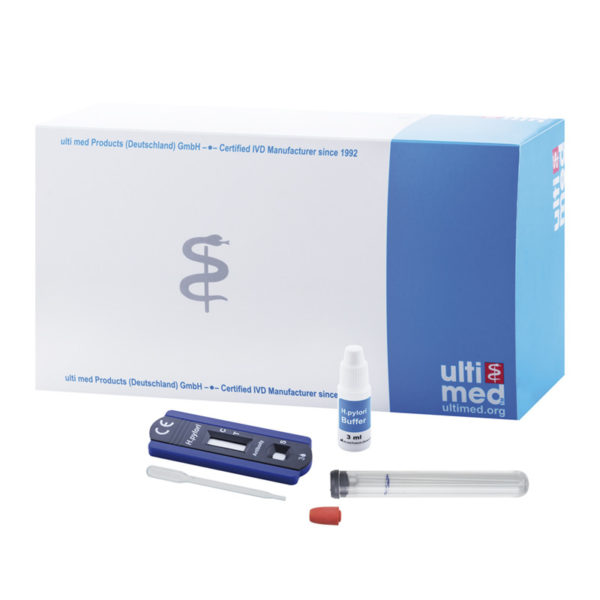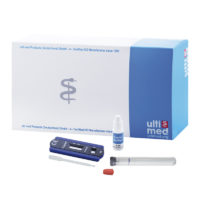H.pylori Antibody Test
- Article ID
- 012L400
- manufacturer
- ulti med Products (Deutschland) GmbH
- Handling time
Product description
The H.pylori Antibody Test is a rapid chromatographic immunoassay for the qualitative detection of antibodies to H.pylori in whole blood, serum or plasma to aid in the diagnosis of H.pylori infection.
Summary
H.pylori is a small, spiral-shaped bacterium that lives in the surface of the stomach and duodenum. It is implicated in the etiology of a variety of gastrointestinal diseases, including duodenal and gastric ulcer, non-ulcer dyspepsia and active and chronic gastritis. Both invasive and non-invasive methods are used to diagnose H.pylori infection in patients with symptoms of gastrointestinal disease. Specimen dependent and costly invasive diagnostic methods include gastric or duodenal biopsy followed by urease testing (presumptive), culture, and/or histological staining. Non-invasive techniques include the urea breath test, which requires expensive laboratory equipment and moderate radiation exposure, and serological methods. Individuals infected with H.pylori develop antibodies which correlate strongly with histologically confirmed H.pylori infection. The H.pylori Antibody Test is a simple test that utilizes a combination of H.pylori antigen coated particles and anti-human IgG to qualitatively and selectively detect H.pylori antibodies in whole blood, serum or plasma.
Test principle
The H.pylori Antibody Test is a qualitative membrane based immunoassay for the detection of H.pylori antibodies in whole blood, serum or plasma. In this test procedure, anti-human IgG is immobilizied in the test line region of the test. After specimen is added to the specimen well of the device, it reacts with H.pylori antigen coated particles in the test. This mixture migrates chromatographically along the length of the test and interacts with the immobilized anti-human IgG. If the specimen contains H.pylori antibodies, a colored line will appear in the test line region indicating a positive result. If the specimen does not contain H.pylori antibodies, a colored line will not appear in this region indicating a negative result. To serve as a procedural control, a colored line will always appear in the control line region, indicating that proper volume of specimen has been added and membrane wicking has occurred.









